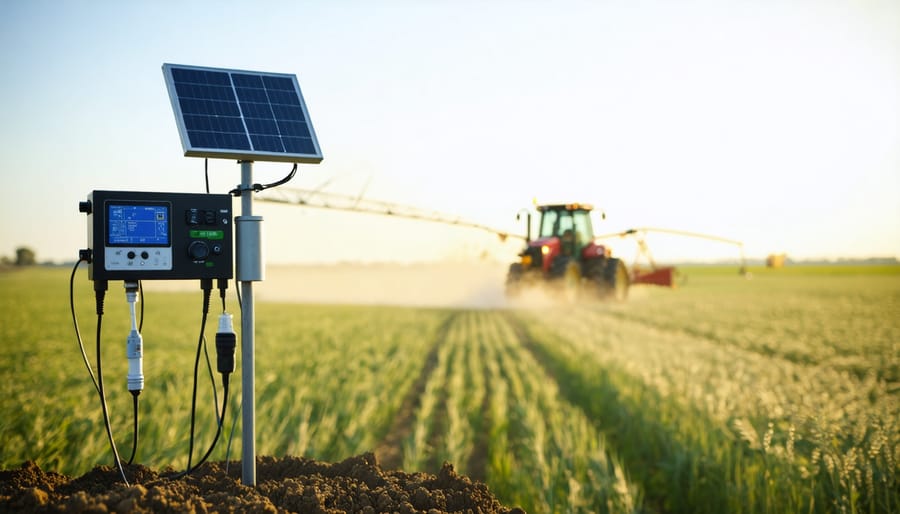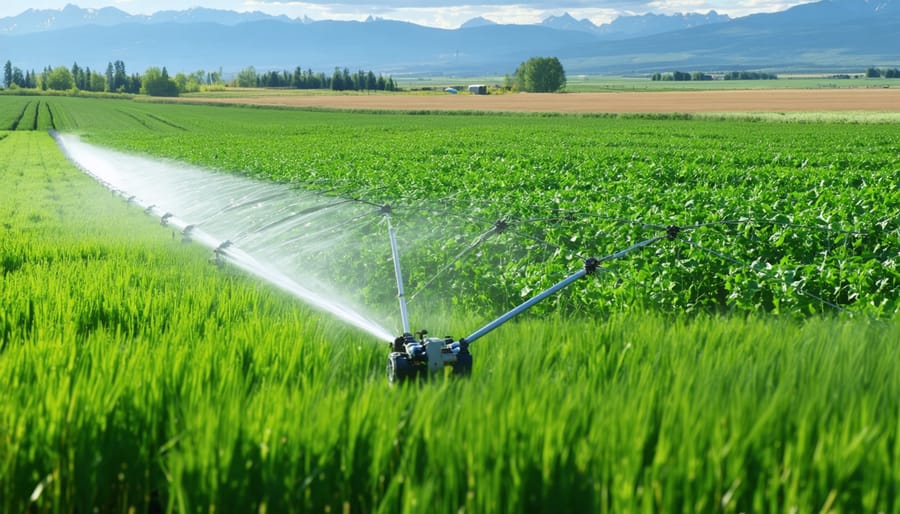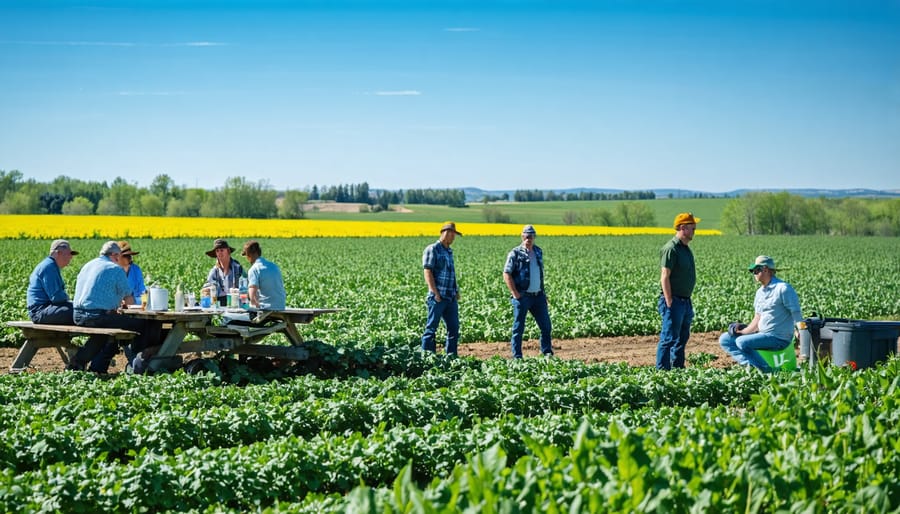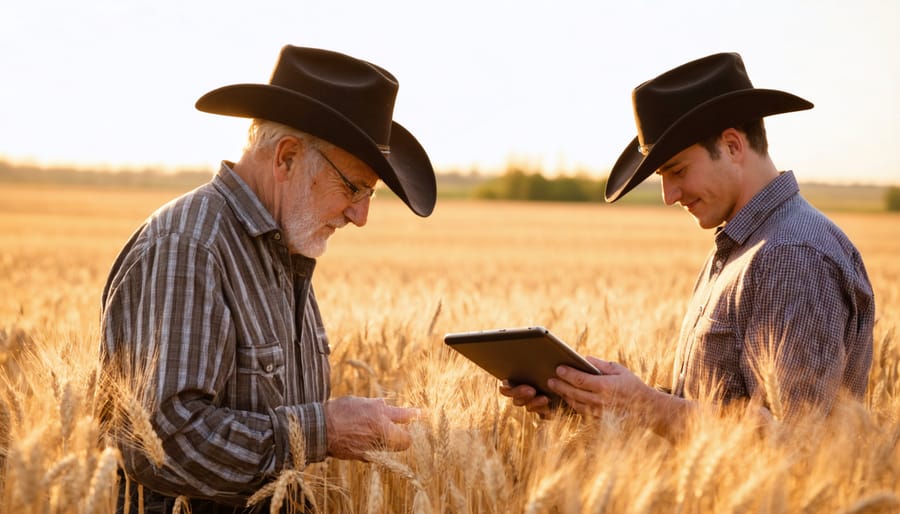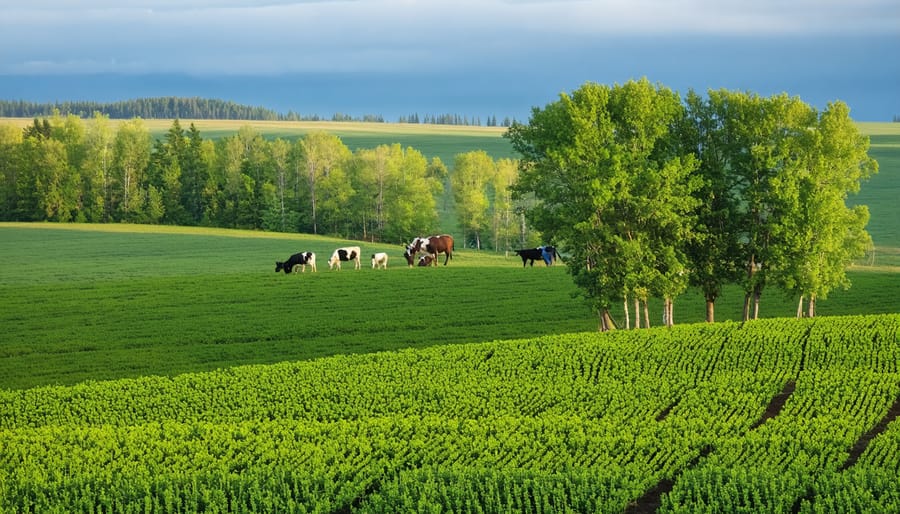Community food systems represent the backbone of sustainable local agriculture, connecting farmers, consumers, and communities in a vital network of food production and distribution. Across Canada, particularly in regions like Alberta, these systems are transforming how we think about food security, agricultural sustainability, and community resilience.
From farm-to-table initiatives in small towns to urban agricultural projects in major cities, community food systems create direct relationships between those who grow our food and those who consume it. These connections foster economic stability for local farmers, ensure fresher produce for consumers, and significantly reduce the environmental impact of long-distance food transportation.
Consider the success of the Innisfail Growers cooperative in central Alberta, where five family farms collaborate to supply fresh produce to local markets and restaurants. Their model demonstrates how community food systems can thrive when producers work together, sharing resources and knowledge while building strong relationships with consumers.
Through innovative approaches like community-supported agriculture (CSA) programs, farmers’ markets, and food hubs, these systems are reshaping our agricultural landscape. They’re not just about food production – they’re about building resilient communities, preserving agricultural heritage, and ensuring sustainable food security for future generations.
The Building Blocks of Sustainable Community Food Systems
Local Production Networks
Local production networks form the backbone of robust community food systems across Alberta and beyond. These networks typically consist of three main components: farmer cooperatives, community gardens, and regional distribution systems working in harmony to strengthen local food security.
Farmer cooperatives in Alberta have shown remarkable success in pooling resources, sharing equipment, and establishing collective marketing strategies. For example, the Peace Region Forage Seed Cooperative has helped small-scale farmers access larger markets while maintaining sustainable farming practices.
Community gardens and urban agriculture initiatives have flourished throughout the province, with notable examples in Edmonton and Calgary where neighbourhood plots provide fresh produce while fostering community connections. These spaces serve both educational and practical purposes, enabling knowledge sharing between experienced farmers and newcomers to agriculture.
Regional distribution systems complete the network by connecting producers directly with consumers. Food hubs like The Organic Box in Edmonton demonstrate how efficient distribution channels can support both farmers and consumers. These systems often incorporate cold storage facilities, transportation networks, and innovative ordering platforms to ensure fresh produce reaches local markets efficiently.
The success of these networks relies heavily on collaboration between farmers, community organizations, and local government support. When properly coordinated, these systems create resilient local food chains that benefit both producers and consumers while reducing food transportation distances and supporting regional economic development.

Educational Integration
Agricultural education plays a vital role in building robust community food systems across Canada. By integrating food and farming education into schools, community centers, and agricultural institutions, we create opportunities for knowledge transfer and skill development that strengthen local food networks.
From elementary school garden programs to post-secondary agricultural studies, educational initiatives help students understand the importance of local food production and generational farming knowledge. These programs often include hands-on experience with growing food, learning about nutrition, and understanding sustainable farming practices.
In Alberta, successful examples include the School Garden Network, which connects over 100 schools with local farmers, and the Young Agrarians mentorship program, which pairs aspiring farmers with experienced producers. These initiatives help bridge the urban-rural divide while ensuring agricultural knowledge continues to flourish in our communities.
Community food systems benefit from educational integration through:
– Practical skill development in sustainable farming methods
– Enhanced understanding of local food production cycles
– Stronger connections between producers and consumers
– Improved food literacy among young people
– Greater appreciation for agricultural careers
By fostering these educational connections, we create a more resilient and knowledgeable community that can better support local food systems for generations to come. This approach ensures that traditional farming wisdom combines with modern sustainable practices to create lasting positive change in our food systems.
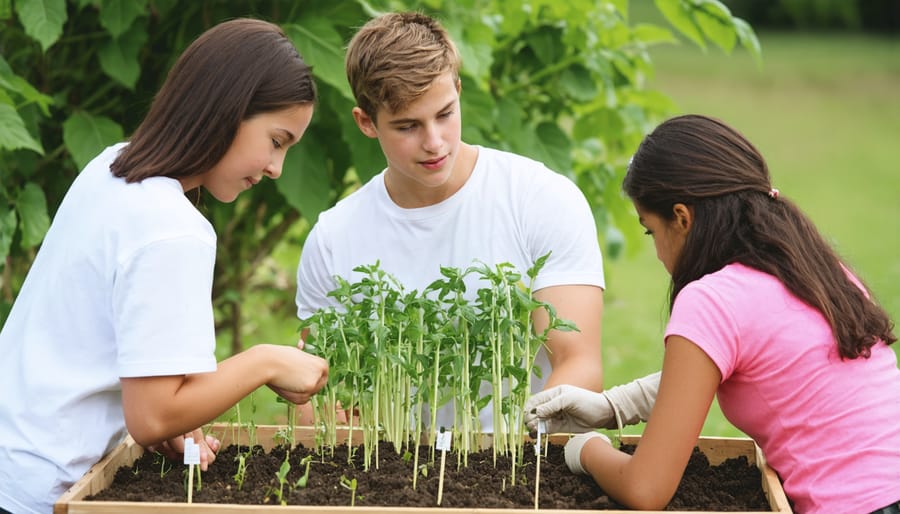
Success Stories: Alberta’s Community Food Initiatives
The Edmonton Food Hub Model
Edmonton’s Food Hub Model stands as a pioneering example of how urban centres can successfully integrate local food systems. The model, developed through collaboration between local farmers, community organizations, and municipal authorities, demonstrates the power of coordinated effort in building sustainable food networks.
At its core, the Edmonton Food Hub operates as a centralized distribution system connecting more than 75 local producers with urban consumers. The hub manages everything from cold storage facilities to delivery logistics, making it easier for small-scale farmers within a 100-kilometre radius to access urban markets efficiently.
What sets Edmonton’s approach apart is its multi-stakeholder governance structure. Local farmers hold voting positions on the hub’s board, ensuring agricultural producers maintain a strong voice in operational decisions. The hub also partners with educational institutions, offering hands-on training for new farmers and food entrepreneurs.
The model has shown impressive results since its 2018 launch. Local food sales through the hub have increased by 45%, with participating farmers reporting an average 30% growth in revenue. The system has also reduced food transportation distances by an average of 65 kilometres per delivery, significantly lowering the environmental impact of food distribution.
Key features of the Edmonton model include:
– Shared cold storage facilities reducing individual infrastructure costs
– Consolidated delivery services optimizing distribution routes
– Online ordering platform connecting producers directly with buyers
– Quality control standards ensuring consistent product quality
– Educational programs supporting new farmer development
The success of Edmonton’s Food Hub demonstrates how thoughtful infrastructure investment and collaborative governance can create resilient local food systems that benefit both producers and consumers.
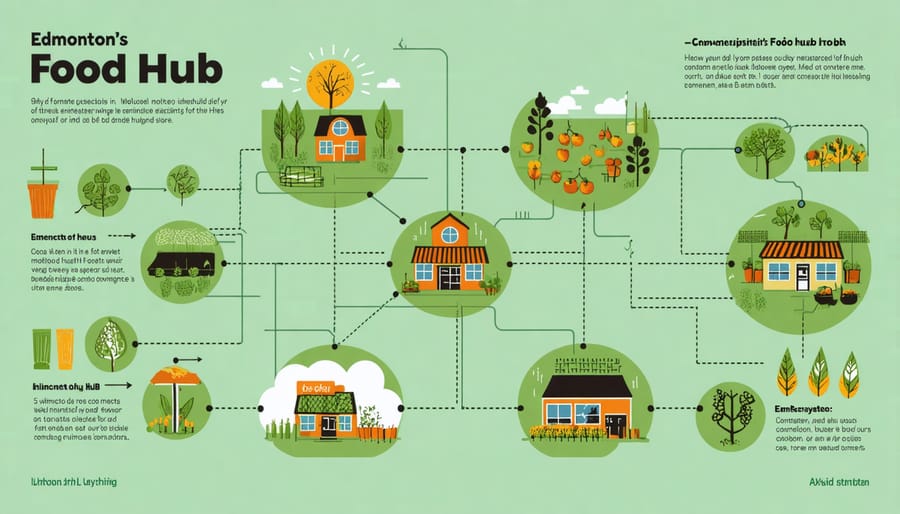
Rural Innovation in Lethbridge County
Lethbridge County has emerged as a beacon of rural food innovation, showcasing how traditional farming communities can adapt to modern challenges while strengthening local food security. The region’s success stems from its innovative approach to combining digital agricultural innovations with community-driven initiatives.
The County’s Farm-to-School program, launched in 2019, has connected local producers with eight area schools, providing fresh, seasonal produce to over 2,000 students. This initiative not only ensures children have access to nutritious local food but also creates stable markets for small-scale farmers.
The Lethbridge Food Share Network, a collaborative effort between farmers, food banks, and community organizations, has developed an efficient distribution system that reduces food waste while increasing access to fresh produce. Using a mobile app for real-time inventory management, the network has successfully redistributed more than 50,000 kg of fresh produce annually that would otherwise have gone to waste.
Local farmers have also embraced cooperative marketing strategies, establishing the Southern Alberta Food Hub, which serves as a centralized distribution point for over 40 producers. This hub has reduced individual transportation costs by 30% and increased market access for small-scale farmers.
The success of these initiatives relies heavily on community engagement and partnership building. Monthly farmer forums provide opportunities for knowledge sharing, while mentorship programs pair experienced producers with newcomers to agriculture. These collaborative approaches have resulted in a 25% increase in local food sales over the past three years, demonstrating the economic viability of community-focused food systems.
Implementing Education-Based Food Systems
Starting Your Community Program
Starting a community food system program begins with building a strong foundation of local support and understanding. First, conduct a community needs assessment by surveying local farmers, residents, and businesses about their food system priorities. This helps identify gaps and opportunities specific to your area.
Next, form a steering committee comprising diverse stakeholders – including farmers, educators, food service professionals, and community leaders. This group will guide program development and ensure broad representation of community interests.
Create an action plan with clear, achievable goals. Start small with initiatives like community gardening success stories and farmers’ markets, then expand based on community response and available resources.
Develop educational materials tailored to your region’s agricultural context. Consider hosting workshops on seasonal growing, food preservation, and sustainable farming practices. Partner with local schools and agricultural organizations to integrate food system education into existing programs.
Secure funding through municipal grants, provincial programs, or community partnerships. Many Alberta communities have successfully launched programs through cost-sharing initiatives and volunteer support.
Remember to document your progress and celebrate small wins. Share success stories through local media and community newsletters to maintain momentum and encourage broader participation. Regular evaluation and feedback from participants will help refine your program and ensure long-term sustainability.
Building Educational Partnerships
Building strong educational partnerships is a cornerstone of successful community food systems across Alberta and beyond. Schools, colleges, and agricultural organizations serve as vital connection points between farmers and future generations of food system leaders.
Start by reaching out to local schools to establish farm-to-school programs. These initiatives can include school gardens, classroom visits from farmers, and field trips to local farms. The Alberta Farm to School Network provides excellent resources and connecting opportunities for educators and producers looking to collaborate.
Post-secondary institutions offer valuable research partnerships and practical learning opportunities. Olds College and Lakeland College, for instance, regularly partner with local farmers to conduct applied research and provide hands-on training for agricultural students. These partnerships often lead to innovative solutions for local food challenges while preparing the next generation of agricultural professionals.
Agricultural organizations like Applied Research Associations and producer groups can facilitate knowledge sharing and networking. Consider joining regional agricultural societies or participating in mentorship programs. The Alberta Young Farmers and Ranchers organization, for example, connects experienced producers with newcomers to agriculture.
To build lasting partnerships:
– Attend agricultural education events and workshops
– Offer your farm as a demonstration site
– Participate in student internship programs
– Share your expertise through guest speaking opportunities
– Collaborate on research projects that benefit your community
Remember that successful partnerships require clear communication, shared goals, and a long-term commitment to supporting agricultural education in your region.
Measuring Impact and Growth
Measuring the success of community food systems requires a balanced approach combining quantitative metrics with qualitative assessments. In Alberta, successful initiatives often track key indicators such as the number of participating farms, volume of local food sales, and the percentage of food dollars staying within the community.
The Southern Alberta Food Security Network demonstrates effective measurement through their annual impact reports, which track both economic and social outcomes. They measure metrics like the number of community gardens established, tonnage of food distributed through local markets, and the number of new farming enterprises launched within the network.
Growth indicators should focus on sustainability and community engagement. Important metrics include:
– Number of participating producers and consumers
– Volume of local food distributed (in kilograms or tonnes)
– Economic impact through local spending
– Number of educational programs and workshops delivered
– Employment opportunities created
– Reduction in food transportation distances
Calgary’s YYC Growers cooperative offers an excellent example of tracking growth through membership engagement. Their system monitors both producer participation and consumer reach, showing a 40% increase in local food distribution over the past three years.
For emerging initiatives, starting with simple measurements like participant numbers and basic sales data can provide a foundation for more complex tracking systems. Regular surveys of both producers and consumers help gather valuable feedback for continuous improvement and community-driven growth.
Community food systems represent more than just a way to produce and distribute food – they’re the foundation of resilient, sustainable communities across Alberta and Canada. Throughout this exploration of community food systems, we’ve seen how local initiatives can transform our relationship with food production, strengthen regional economies, and build lasting connections between farmers and consumers.
The success stories from across Alberta demonstrate that when communities come together to support local agriculture, everyone benefits. From the farmer’s markets in Edmonton to the community-supported agriculture programs in rural regions, these systems are creating positive change in how we grow, distribute, and consume food.
As we look to the future of Canadian agriculture, the importance of community food systems cannot be overstated. They offer solutions to pressing challenges like food security, environmental sustainability, and economic resilience. By shortening supply chains, reducing food transportation distances, and keeping profits within local communities, these systems create a more sustainable and equitable food future.
For those looking to get involved, there are numerous entry points. Consider joining a local food policy council, supporting nearby farmers through direct purchasing, or starting a community garden. Farmers can explore opportunities to diversify their operations and build direct relationships with consumers. Agricultural professionals can lend their expertise to strengthen existing systems or help establish new ones.
The time to act is now. Climate change and global supply chain disruptions have shown us the vulnerability of conventional food systems. By investing in community food systems today, we’re investing in food security and community resilience for tomorrow.
Remember, every step toward strengthening local food systems matters, whether it’s choosing to buy from local producers, participating in community agriculture initiatives, or advocating for policies that support regional food production. Together, we can build a more sustainable and connected food future for Alberta and beyond.


